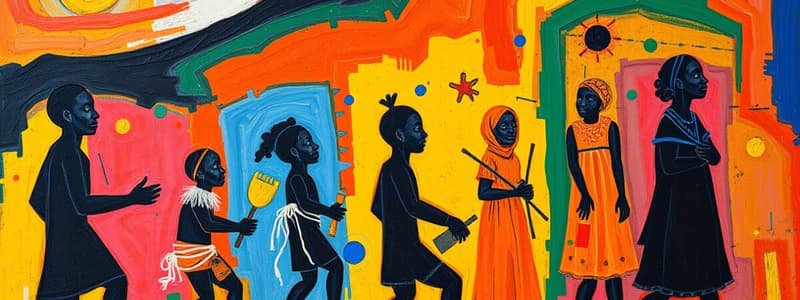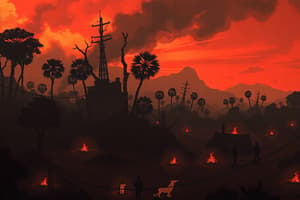Podcast
Questions and Answers
What is the term for the classification of individuals based on political identity in the Rwandan genocide?
What is the term for the classification of individuals based on political identity in the Rwandan genocide?
Classification
What characteristic is often associated with the Tutsi in Rwandan genocide context?
What characteristic is often associated with the Tutsi in Rwandan genocide context?
- Tall and thin (correct)
- Short and strong
- Broad features (correct)
- All of the above
What was a key reason for the discrimination against Tutsis?
What was a key reason for the discrimination against Tutsis?
Hutu revolted against the control of Tutsis and Belgians
Hutus referred to Tutsis in dehumanizing terms during the genocide.
Hutus referred to Tutsis in dehumanizing terms during the genocide.
What did the Hutus organize against the Tutsis?
What did the Hutus organize against the Tutsis?
What form of media played a significant role in the polarization during the Rwandan genocide?
What form of media played a significant role in the polarization during the Rwandan genocide?
What incentives were provided to participants in the extremist actions?
What incentives were provided to participants in the extremist actions?
What happened to identified victims during the persecution stage?
What happened to identified victims during the persecution stage?
In what manner did the Hutus conduct extermination of Tutsis?
In what manner did the Hutus conduct extermination of Tutsis?
What was used to conceal the atrocities committed during the genocide?
What was used to conceal the atrocities committed during the genocide?
Flashcards are hidden until you start studying
Study Notes
Stages of Genocide in the Rwandan Genocide
-
Classification: Hutu extremists targeted political opponents within the Rwandan government, including the prime minister, incentivizing participation in purges through offers of money or food.
-
Symbolization: Physical differences between Tutsis and Hutus were emphasized, with Tutsis generally taller and thinner while Hutus were shorter and broader. Identity cards designated the ethnic categories of all Rwandan citizens.
-
Discrimination: The Hutu uprising against Tutsi and Belgian control led to widespread violence, resulting in the killing of Tutsis as a means of asserting power.
-
Dehumanization: Hutus referred to Tutsis using derogatory terms like "cockroaches" and "vermin," which facilitated a perception of Tutsis as subhuman and justified their extermination.
-
Organization: Attacks against Tutsis were systematically planned, using identity cards introduced by Belgian colonizers to identify and target Tutsis for violence.
-
Polarization: Propaganda incited hatred and violence, with radio broadcasts ordering Hutus to "encircle" and kill Tutsis, framing them as threats to the nation and promoting wide participation in genocide.
-
Preparation: Leading up to the genocide, Hutu extremists purged the government and incentivized participation by promising land from killed Tutsis. Importation of weapons was coordinated for anticipated attacks.
-
Persecution: Targeted individuals were identified, forcibly relocated to camps, and children were sent to orphanages, showcasing systematic attempts to isolate and erase the Tutsi population.
-
Extermination: Armed Hutus engaged in mass killings of Tutsis, often using machetes to execute anyone identified as Tutsi, reflecting the brutality and scale of the violence.
-
Denial: Following the genocide, the Rwandan government attempted to erase evidence by using mass graves and presenting the events as a "civil war," obscuring the reality of the genocide from the public and international community.
Studying That Suits You
Use AI to generate personalized quizzes and flashcards to suit your learning preferences.




